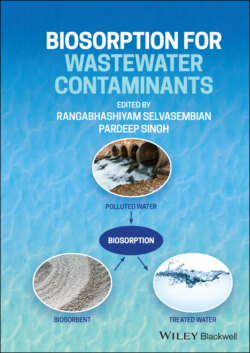Читать книгу Biosorption for Wastewater Contaminants - Группа авторов - Страница 29
Bacterial Biomass
ОглавлениеOf the microorganisms, bacteria are the world's most abundant, versatile, and diverse creatures. Bacteria can be classified as gram‐negative or gram‐positive based on the cell wall and gram staining. In biosorption, the cell surface structure plays an important role.
The first aspect of biosorption is the bacterial cell wall that encounters the metal ion. The bacterial cell wall consists mainly of peptidoglycan, which defines its form and rigidity. Gram‐positive bacteria consist of a thick peptidoglycan layer (90%) connected by amino acids. Teichoic acids bind to cytoplasmic membrane lipids in the cell wall, generating lipoteichoic acids that are strongly linked to the membrane. The phosphodiester linkages between the monomers of teichoic acid have an overall negative effect and are thus engaged in the biosorption of divalent cations (metal ions).Gram‐negative bacteria have thinner walls that contain less peptidoglycan (20%). However, there is an additional external layer made up of phospholipids and lipopolysaccharides that has a negative charge, making metal binding easier (Shamim, 2018). For their survival, the majority of bacteria have a variety of resistance mechanisms as well as effective strategies for extracting metal ions. On the cell wall surface, certain bacteria produce slime or a capsule‐like coating. This consists mainly of polysaccharides that lead to the detoxification of metal ions from wastewaters (Moat et al., 2002).
Bacteria are excellent biosorbents for sequestering metal ions because of their high surface‐to‐volume ratios and significant numbers of possible active sorption sites (Kanamarlapudi et al., 2018). The bacterial strains Aeromonas sp, Pseudomonas sp, Acinetobacter sp, Enterobacter sp, Klebsiella sp, and Streptomonas spare commonly utilized for wastewater cleanup. The biosorption of toxic metals by several bacterial species is summarized in Table 2.1.
The functional groups of the cell wall, such as hydroxyl, amine, carboxyl, sulfate, and phosphate, play an essential part in the biosorption process. The metal ions become attached to the functional groups on the cell wall. The general process of metal absorption includes the attachment of metal ions to reactive groups located on bacterial cell walls and the internalization of metal ions within cells (Abbas et al., 2014). The presence of glycoproteins allows more metal to be taken by gram‐positive bacteria. Less metal absorption is observed in gram‐negative bacteria due to phospholipids and lipopolysaccharides (Das et al., 2008). The action of Van der Waals forces can lead to weak physical sorption, while relatively strong physical sorption may be due to electrostatic attractions between metal ions and functional groups in the surface (Aryal, 2020). The bacteria's biosorption mechanisms and characterization have been investigated by various methods such as X‐ray diffraction, electron scanners, transmission electron microscopy, Fourier infrared spectroscopy transformation, potentiometric titrations, and energy‐dispersive X‐ray microanalysis. These methods have revealed the existence, type, and number of binding sites on the bacterial surface (Kazy et al., 2006).
Studies have identified numerous means of improving the bacterial capacity to function as biosorbents, including chemical and genetic modification. Some concentrated on improving the active sites to enhance biosorption, while the inhibition sites on the surface of the bacteria were less often taken into consideration (Adewuyi, 2020). For large‐scale domestic and industrial wastewater treatment, several membrane bioreactors have been developed. The application of the membrane reactor has shown many advantages such as operational stability, prolonged preservation of the microorganism, maximum removal of suspended solids, low sludge production rate, ability to treat toxic organic and inorganic contaminants, compact plant size, and high degradation rate (Rana et al., 2017).
